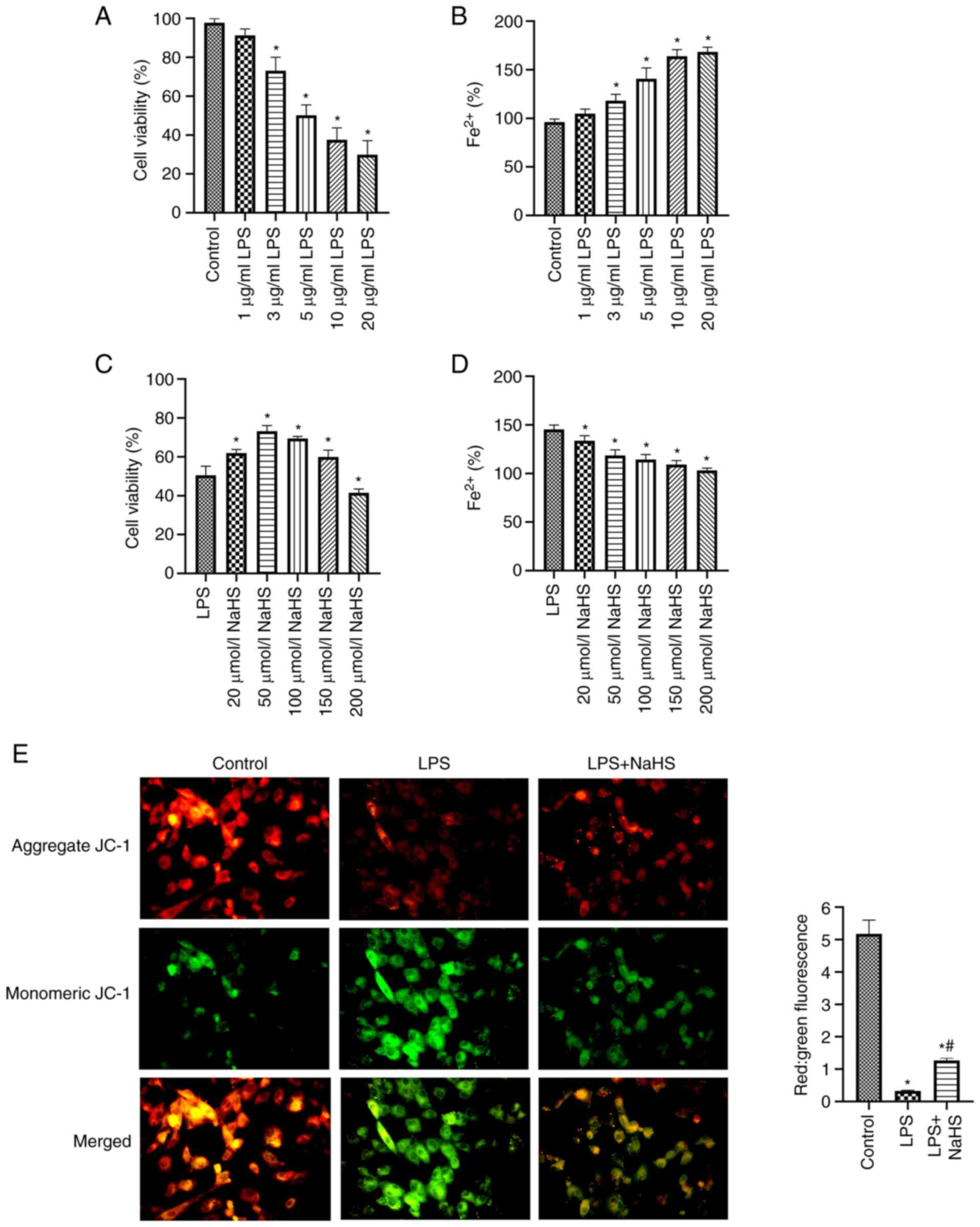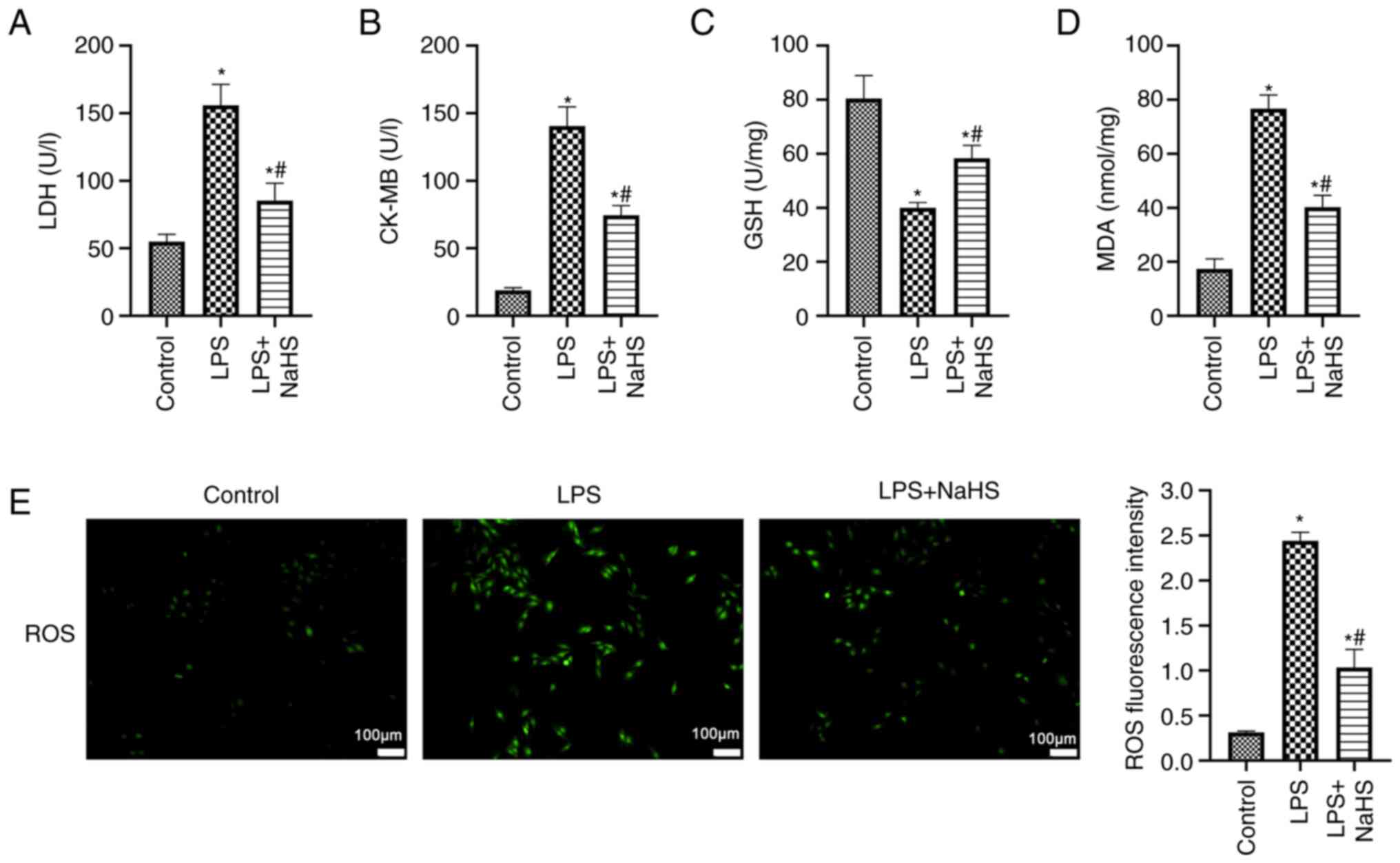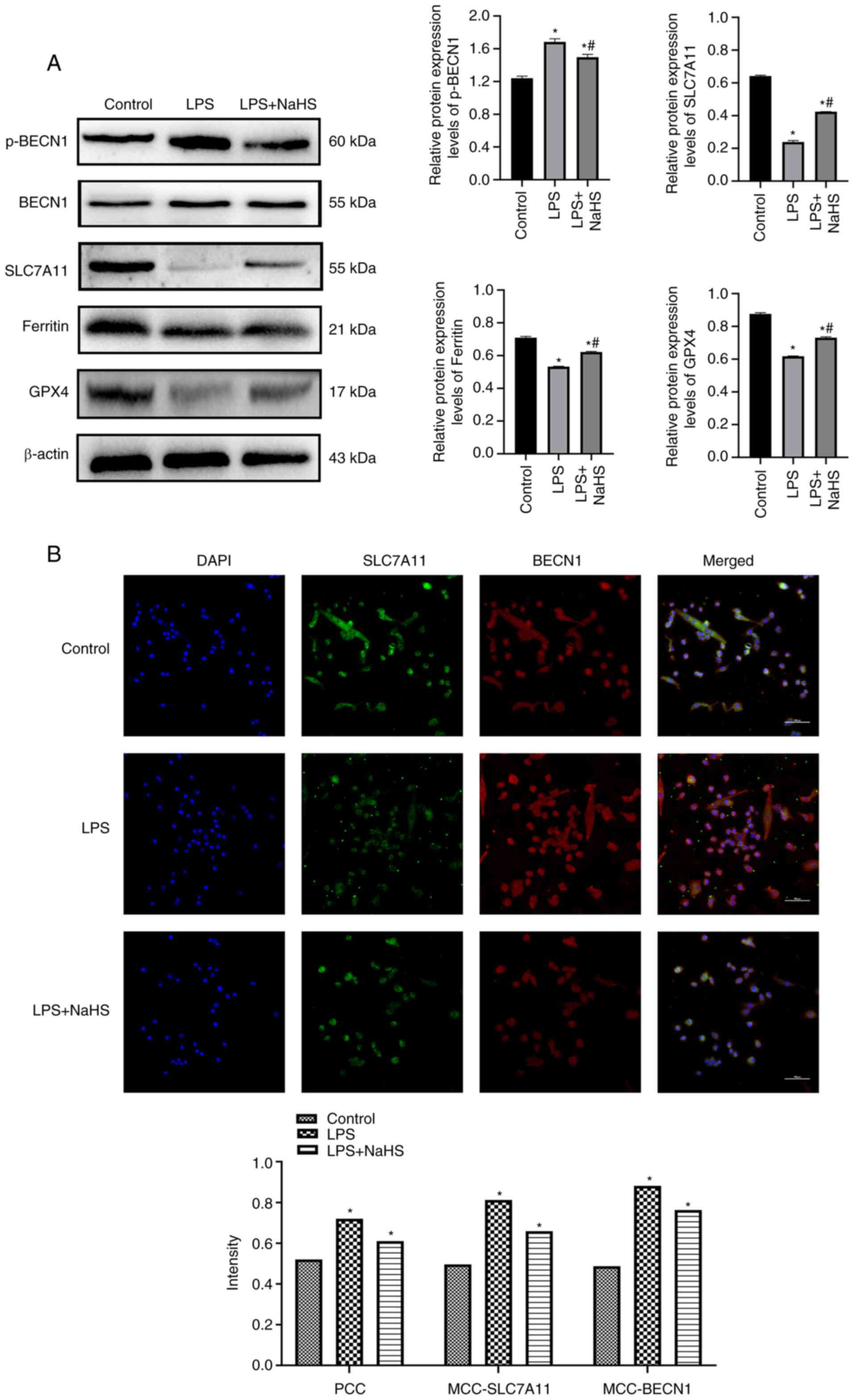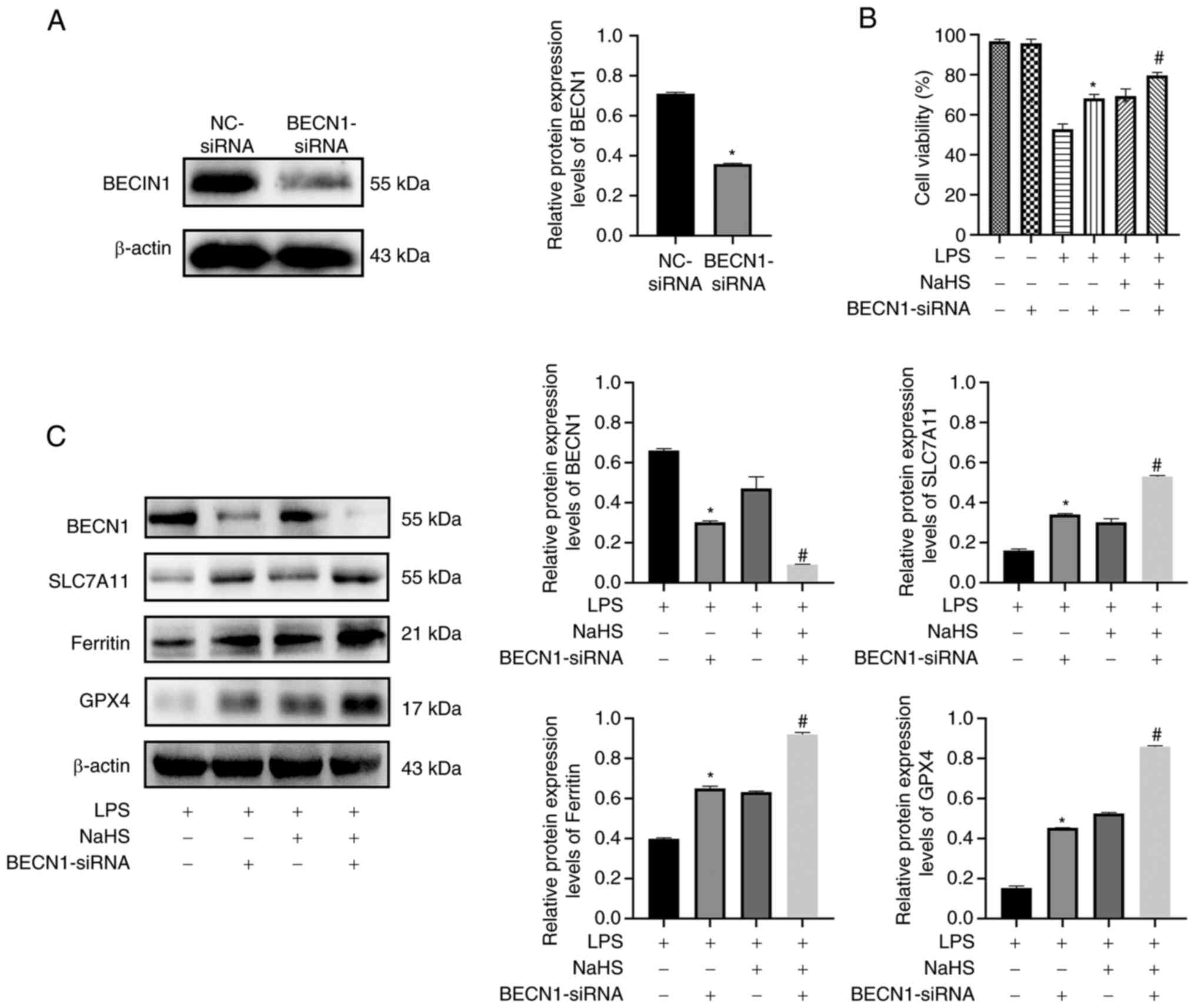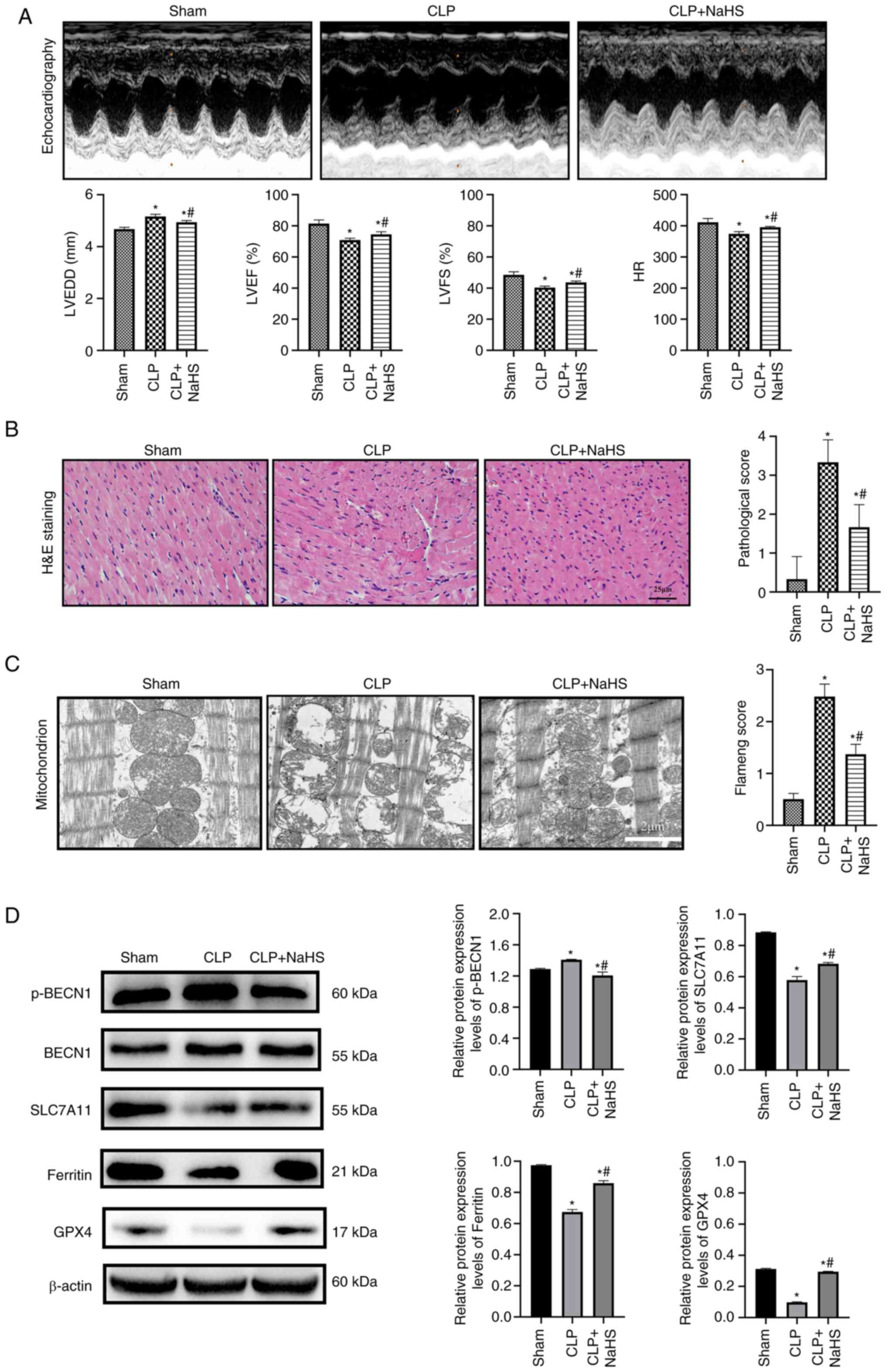|
1
|
Shankar-Hari M, Phillips GS, Levy ML,
Seymour CW, Liu VX, Deutschman CS, Angus DC, Rubenfeld GD and
Singer M; Sepsis Definitions Task Force, : Developing a new
definition and assessing new clinical criteria for septic shock:
For the third international consensus definitions for sepsis and
septic shock (sepsis-3). JAMA. 315:775–787. 2016. View Article : Google Scholar : PubMed/NCBI
|
|
2
|
Evans L, Rhodes A, Alhazzani W, Antonelli
M, Coopersmith CM, French C, Machado FR, Mcintyre L, Ostermann M,
Prescott HC, et al: Surviving sepsis campaign: International
guidelines for management of sepsis and septic shock 2021.
Intensive Care Med. 47:1181–1247. 2021. View Article : Google Scholar : PubMed/NCBI
|
|
3
|
Beesley SJ, Weber G, Sarge T, Nikravan S,
Grissom CK, Lanspa MJ, Shahul S and Brown SM: Septic
cardiomyopathy. Crit Care Med. 46:625–634. 2018. View Article : Google Scholar : PubMed/NCBI
|
|
4
|
Hollenberg SM and Singer M:
Pathophysiology of sepsis-induced cardiomyopathy. Nat Rev Cardiol.
18:424–434. 2021. View Article : Google Scholar
|
|
5
|
Fang X, Wang H, Han D, Xie E, Yang X, Wei
J, Gu S, Gao F, Zhu N, Yin X, et al: Ferroptosis as a target for
protection against cardiomyopathy. Proc Natl Acad Sci USA.
116:2672–2680. 2019. View Article : Google Scholar : PubMed/NCBI
|
|
6
|
Dixon SJ, Lemberg KM, Lamprecht MR, Skouta
R, Zaitsev EM, Gleason CE, Patel DN, Bauer AJ, Cantley AM, Yang WS,
et al: Ferroptosis: An iron-dependent form of nonapoptotic cell
death. Cell. 149:1060–1072. 2021. View Article : Google Scholar
|
|
7
|
Koppula P, Zhuang L and Gan B: Cystine
transporter SLC7A11/xCT in cancer: Ferroptosis, nutrient
dependency, and cancer therapy. Protein Cell. 12:599–620. 2021.
View Article : Google Scholar
|
|
8
|
Zhang X, Zheng C, Gao Z, Chen H, Li K,
Wang L, Zheng Y, Li C, Zhang H, Gong M, et al: SLC7A11/xCT prevents
cardiac hypertrophy by inhibiting ferroptosis. Cardiovasc Drugs
Ther. 36:437–447. 2022. View Article : Google Scholar : PubMed/NCBI
|
|
9
|
Zheng J and Conrad M: The metabolic
underpinnings of ferroptosis. Cell Metab. 32:920–937. 2020.
View Article : Google Scholar : PubMed/NCBI
|
|
10
|
Ge ZD, Lian Q, Mao X and Xia Z: Current
Status and challenges of NRF2 as a potential therapeutic target for
diabetic cardiomyopathy. Int Heart J. 60:512–520. 2019. View Article : Google Scholar : PubMed/NCBI
|
|
11
|
Zhang H, Wang Z, Liu Z, Du K and Lu X:
Protective effects of dexazoxane on rat ferroptosis in
doxorubicin-induced cardiomyopathy through regulating HMGB1. Front
Cardiovasc Med. 8:6854342021. View Article : Google Scholar : PubMed/NCBI
|
|
12
|
Khamseekaew J, Kumfu S, Wongjaikam S,
Kerdphoo S, Jaiwongkam T, Srichairatanakool S, Fucharoen S,
Chattipakorn SC and Chattipakorn N: Effects of iron overload, an
iron chelator and a T-type calcium channel blocker on cardiac
mitochondrial biogenesis and mitochondrial dynamics in thalassemic
mice. Eur J Pharmacol. 799:118–127. 2017. View Article : Google Scholar
|
|
13
|
Liu P, Feng Y, Li H, Chen X, Wang G, Xu S,
Li Y and Zhao L: Ferrostatin-1 alleviates
lipopolysaccharide-induced acute lung injury via inhibiting
ferroptosis. Cell Mol Biol Lett. 25:102020. View Article : Google Scholar
|
|
14
|
Belavgeni A, Meyer C, Stumpf J, Hugo C and
Linkermann A: Ferroptosis and necroptosis in the kidney. Cell Chem
Biol. 27:448–462. 2020. View Article : Google Scholar
|
|
15
|
Kimura H, Nagai Y, Umemura K and Kimura Y:
Physiological roles of hydrogen sulfide: Synaptic modulation,
neuroprotection, and smooth muscle relaxation. Antioxid Redox
Signal. 7:795–803. 2005. View Article : Google Scholar
|
|
16
|
Guo W, Cheng ZY and Zhu YZ: Hydrogen
sulfide and translational medicine. Acta Pharmacol Sin.
34:1284–1291. 2013. View Article : Google Scholar : PubMed/NCBI
|
|
17
|
Bhatia M and Gaddam RR: Hydrogen sulfide
in inflammation: A novel mediator and therapeutic target. Antioxid
Redox Signal. 34:1368–1377. 2021. View Article : Google Scholar
|
|
18
|
Yang R, Teng X, Li H, Xue HM, Guo Q, Xiao
L and Wu YM: Hydrogen sulfide improves vascular calcification in
rats by inhibiting endoplasmic reticulum stress. Oxid Med Cell
Longev. 2016:90952422016. View Article : Google Scholar : PubMed/NCBI
|
|
19
|
Sen N, Paul BD, Gadalla MM, Mustafa AK,
Sen T, Xu R, Kim S and Snyder SH: Hydrogen sulfide-linked
sulfhydration of NF-κB mediates its antiapoptotic actions. Mol
Cell. 45:13–24. 2012. View Article : Google Scholar
|
|
20
|
Gotor C, García I, Crespo JL and Romero
LC: Sulfide as a signaling molecule in autophagy. Autophagy.
9:609–611. 2013. View Article : Google Scholar : PubMed/NCBI
|
|
21
|
Chen YH, Teng X, Hu ZJ, Tian DY, Jin S and
Wu YM: Hydrogen sulfide attenuated sepsis-induced myocardial
dysfunction through TLR4 pathway and endoplasmic reticulum stress.
Front Physiol. 12:6536012021. View Article : Google Scholar
|
|
22
|
Liang D and Huang A, Jin Y, Lin M, Xia X,
Chen X and Huang A: Protective effects of exogenous NaHS against
sepsis-induced myocardial mitochondrial injury by enhancing the
PGC-1α/NRF2 pathway and mitochondrial biosynthesis in mice. Am J
Transl Res. 10:1422–1430. 2018.PubMed/NCBI
|
|
23
|
Li T, Zhao J, Miao S, Chen Y, Xu Y and Liu
Y: Protective effect of H2S on LPS-induced AKI by
promoting autophagy. Mol Med Rep. 25:962022. View Article : Google Scholar : PubMed/NCBI
|
|
24
|
Dunn KW, Kamocka MM and McDonald JH: A
practical guide to evaluating colocalization in biological
microscopy. Am J Physiol Cell Physiol. 300:C723–C742. 2011.
View Article : Google Scholar
|
|
25
|
Hollands C: The animals (scientific
procedures) Act 1986. Lancet. 2:32–33. 1986. View Article : Google Scholar
|
|
26
|
Li X, Cheng Q, Li J, He Y, Tian P and Xu
C: Significance of hydrogen sulfide in sepsis-induced myocardial
injury in rats. Exp Ther Med. 14:2153–2161. 2017. View Article : Google Scholar : PubMed/NCBI
|
|
27
|
Zhao Y and Cheng Q: Exogenous
H2S protects against septic cardiomyopathy by inhibiting
autophagy through the AMPK/mTOR pathway. Contrast Media Mol
Imaging. 2022:84640822022. View Article : Google Scholar : PubMed/NCBI
|
|
28
|
Kishimoto C, Kawamata H, Sakai S,
Shinohara H and Ochiai H: Enhanced production of macrophage
inflammatory protein 2 (MIP-2) by in vitro and in vivo infections
with encephalomyocarditis virus and modulation of myocarditis with
an antibody against MIP-2. J Virol. 75:1294–1300. 2001. View Article : Google Scholar
|
|
29
|
Flameng W, Borgers M, Daenen W and
Stalpaert G: Ultrastructural and cytochemical correlates of
myocardial protection by cardiac hypothermia in man. J Thorac
Cardiovasc Surg. 79:413–424. 1980. View Article : Google Scholar : PubMed/NCBI
|
|
30
|
Baghela A, Pena OM, Lee AH, Baquir B,
Falsafi R, An A, Farmer SW, Hurlburt A, Mondragon-Cardona A, Rivera
JD, et al: Predicting sepsis severity at first clinical
presentation: The role of endotypes and mechanistic signatures.
EBioMedicine. 75:1037762022. View Article : Google Scholar : PubMed/NCBI
|
|
31
|
Vallabhajosyula S, Shankar A, Vojjini R,
Cheungpasitporn W, Sundaragiri PR, DuBrock HM, Sekiguchi H, Frantz
RP, Cajigas HR, Kane GC and Oh JK: Impact of right ventricular
dysfunction on short-term and long-term mortality in sepsis: A
meta-analysis of 1,373 patients. Chest. 159:2254–2263. 2021.
View Article : Google Scholar
|
|
32
|
Dickson K and Lehmann C: Inflammatory
response to different toxins in experimental sepsis models. Int J
Mol Sci. 20:43412019. View Article : Google Scholar
|
|
33
|
Hao R and Su G, Sun X, Kong X, Zhu C and
Su G: Adiponectin attenuates lipopolysaccharide-induced cell injury
of H9c2 cells by regulating AMPK pathway. Acta Biochim Biophys Sin
(Shanghai). 51:168–177. 2019. View Article : Google Scholar : PubMed/NCBI
|
|
34
|
Wang Y, Wang S, Xin Y, Zhang J, Wang S,
Yang Z and Liu C: Hydrogen sulfide alleviates the anxiety-like and
depressive-like behaviors of type 1 diabetic mice via inhibiting
inflammation and ferroptosis. Life Sci. 278:1195512021. View Article : Google Scholar
|
|
35
|
Kabil O and Banerjee R: Enzymology of H2S
biogenesis, decay and signaling. Antioxid Redox Signal. 20:770–782.
2014. View Article : Google Scholar
|
|
36
|
Zhang Z, Jin S, Teng X, Duan X, Chen Y and
Wu Y: Hydrogen sulfide attenuates cardiac injury in takotsubo
cardiomyopathy by alleviating oxidative stress. Nitric Oxide.
67:10–25. 2017. View Article : Google Scholar : PubMed/NCBI
|
|
37
|
Wallace JL, Blackler RW, Chan MV, Da Silva
GJ, Elsheikh W, Flannigan KL, Gamaniek I, Manko A, Wang L, Motta JP
and Buret AG: Anti-inflammatory and cytoprotective actions of
hydrogen sulfide: Translation to therapeutics. Antioxid Redox
Signal. 22:398–410. 2015. View Article : Google Scholar
|
|
38
|
Zhang S, Yang G, Guan W, Li B, Feng X and
Fan H: Autophagy plays a protective role in sodium
hydrosulfide-induced acute lung injury by attenuating oxidative
stress and inflammation in rats. Chem Res Toxicol. 34:857–864.
2021. View Article : Google Scholar
|
|
39
|
Chen L, Liu P, Feng X and Ma C:
Salidroside suppressing LPS-induced myocardial injury by inhibiting
ROS-mediated PI3K/Akt/mTOR pathway in vitro and in vivo. J Cell Mol
Med. 21:3178–3189. 2017. View Article : Google Scholar : PubMed/NCBI
|
|
40
|
Wang C, Yuan W, Hu A, Lin J, Xia Z, Yang
CF, Li Y and Zhang Z: Dexmedetomidine alleviated sepsis-induced
myocardial ferroptosis and septic heart injury. Mol Med Rep.
22:175–184. 2020. View Article : Google Scholar : PubMed/NCBI
|
|
41
|
Ursini F and Maiorino M: Lipid
peroxidation and ferroptosis: The role of GSH and GPX4. Free Radic
Biol Med. 152:175–185. 2020. View Article : Google Scholar : PubMed/NCBI
|
|
42
|
Sun L, Dong H, Zhang W, Wang N, Ni N, Bai
X and Liu N: Lipid peroxidation, GSH depletion, and SLC7A11
inhibition are common causes of EMT and ferroptosis in A549 cells,
but different in specific mechanisms. DNA Cell Biol. 40:172–183.
2021. View Article : Google Scholar
|
|
43
|
Park E and Chung SW: ROS-mediated
autophagy increases intracellular iron levels and ferroptosis by
ferritin and transferrin receptor regulation. Cell Death Dis.
10:8222019. View Article : Google Scholar : PubMed/NCBI
|
|
44
|
Su LJ, Zhang JH, Gomez H, Murugan R, Hong
X, Xu D, Jiang F and Peng ZY: Reactive oxygen species-induced lipid
peroxidation in apoptosis, autophagy, and ferroptosis. Oxid Med
Cell Longev. 2019:50808432019. View Article : Google Scholar : PubMed/NCBI
|
|
45
|
Imai H, Matsuoka M, Kumagai T, Sakamoto T
and Koumura T: Lipid peroxidation-dependent cell death regulated by
GPx4 and ferroptosis. Curr Top Microbiol Immunol. 403:143–170.
2017.
|
|
46
|
Li J, Li M, Li L, Ma J, Yao C and Yao S:
Hydrogen sulfide attenuates ferroptosis and stimulates autophagy by
blocking mTOR signaling in sepsis-induced acute lung injury. Mol
Immunol. 141:318–327. 2022. View Article : Google Scholar
|
|
47
|
Liang D, Minikes AM and Jiang X:
Ferroptosis at the intersection of lipid metabolism and cellular
signaling. Mol Cell. 82:2215–2227. 2022. View Article : Google Scholar
|
|
48
|
Gao M, Yi J, Zhu J, Yi J, Zhu J, Minikes
AM, Monian P, Thompson CB and Jiang X: Role of mitochondria in
ferroptosis. Mol Cell. 73:354–363.e3. 2019. View Article : Google Scholar
|
|
49
|
Fang X, Cai Z, Wang H, Han D, Cheng Q,
Zhang P, Gao F, Yu Y, Song Z, Wu Q, et al: Loss of cardiac ferritin
H facilitates cardiomyopathy via Slc7a11-mediated ferroptosis. Circ
Res. 127:486–501. 2020. View Article : Google Scholar : PubMed/NCBI
|
|
50
|
He YJ, Liu XY, Xing L, Wan X, Chang X and
Jiang HL: Fenton reaction-independent ferroptosis therapy via
glutathione and iron redox couple sequentially triggered lipid
peroxide generator. Biomaterials. 241:1199112020. View Article : Google Scholar : PubMed/NCBI
|
|
51
|
Li N, Wang W, Zhou H, Wu Q, Duan M, Liu C,
Wu H, Deng W, Shen D and Tang Q: Ferritinophagy-mediated
ferroptosis is involved in sepsis-induced cardiac injury. Free
Radic Biol Med. 160:303–318. 2020. View Article : Google Scholar : PubMed/NCBI
|
|
52
|
Tang D, Chen X, Kang R and Kroemer G:
Ferroptosis: Molecular mechanisms and health implications. Cell
Res. 31:107–125. 2021. View Article : Google Scholar : PubMed/NCBI
|
|
53
|
Kuramoto K and He C: The secretory
function of BECN1 in metabolic regulation. Autophagy. 17:3262–3263.
2021. View Article : Google Scholar : PubMed/NCBI
|
|
54
|
Hu F, Li G, Huang C, Hou Z, Yang X, Luo X,
Feng Y, Wang G, Hu J and Cao Z: The autophagy-independent role of
BECN1 in colorectal cancer metastasis through regulating STAT3
signaling pathway activation. Cell Death Dis. 11:3042020.
View Article : Google Scholar : PubMed/NCBI
|
|
55
|
Lee S, Lee SJ, Coronata AA, Fredenburgh
LE, Chung SW, Perrella MA, Nakahira K, Ryter SW and Choi AM: Carbon
monoxide confers protection in sepsis by enhancing beclin
1-dependent autophagy and phagocytosis. Antioxid Redox Signal.
20:432–442. 2014. View Article : Google Scholar
|
|
56
|
Pi QZ, Wang XW, Jian ZL, Chen D, Zhang C
and Wu QC: Melatonin alleviates cardiac dysfunction via increasing
Sirt1-mediated beclin-1 deacetylation and autophagy during sepsis.
Inflammation. 44:1184–1193. 2021. View Article : Google Scholar : PubMed/NCBI
|
|
57
|
Song X, Zhu S, Chen P, Hou W, Wen Q, Liu
J, Xie Y, Liu J, Klionsky DJ, Kroemer G, et al: AMPK-mediated BECN1
phosphorylation promotes ferroptosis by directly blocking system
Xc− activity. Curr Biol. 28:2388–2399.e5.
2018. View Article : Google Scholar
|
|
58
|
Kang R, Zhu S, Zeh HJ, Klionsky DJ and
Tang D: BECN1 is a new driver of ferroptosis. Autophagy.
14:2173–2175. 2018. View Article : Google Scholar : PubMed/NCBI
|
|
59
|
Yin Z, Ding G, Chen X, Qin X, Xu H, Zeng
B, Ren J, Zheng Q and Wang S: Beclin1 haploinsufficiency rescues
low ambient temperature-induced cardiac remodeling and contractile
dysfunction through inhibition of ferroptosis and mitochondrial
injury. Metabolism. 113:1543972020. View Article : Google Scholar : PubMed/NCBI
|
|
60
|
Liu R, Li X and Zhao G: Beclin1-mediated
ferroptosis activation is associated with isoflurane-induced
toxicity in SH-SY5Y neuroblastoma cells. Acta Biochim Biophys Sin
(Shanghai). 51:1134–1141. 2019. View Article : Google Scholar : PubMed/NCBI
|















